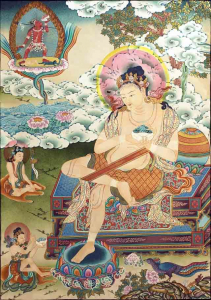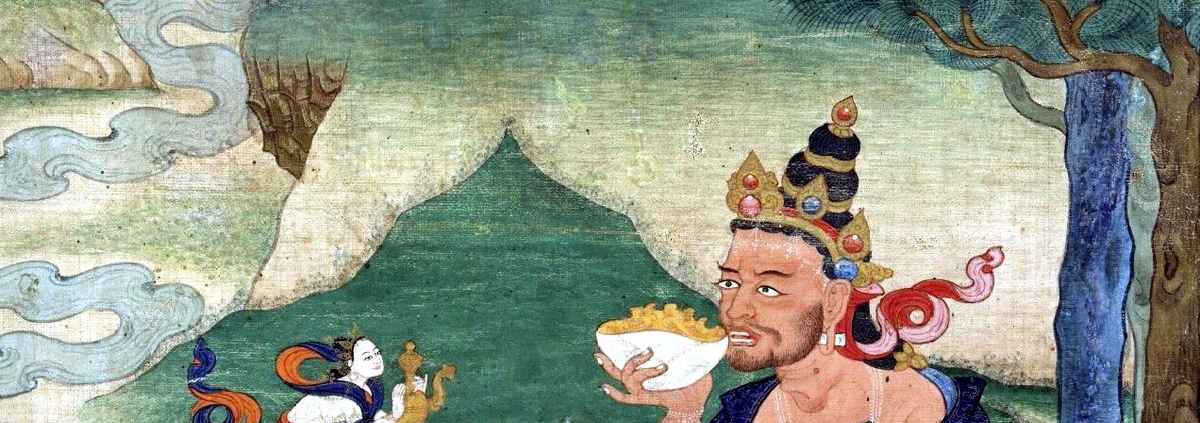A Dakini Messenger
Dakinis in the Life of Naropa
by Pema Khandro
Dakini of the Words & Meanings
Whenever people tell me what they think “Dakini” means, I remember the scene in the Naropa story. It starts with this foreboding phrase, “A shadow fell over Naropa…” But then it goes onto tell a story of the Dakini as a quirky messenger for the importance of meditation practice. Here is the story in short.
A shawdow fell over Naropa… Naropa turned and saw an old woman with bizarre features. Naropa was a great scholar and triumphant debater at Nalanda. This was the famous Buddhist University in Naropa’s lifetime, the eleventh century. Naropa was a famed Buddhist intellectual there. One day, Naropa was studying when a shadow fell over him. He turned and that was when he saw this woman with disheveled hair, a wrinkled face, a dark blue complexion and a walking stick. She had a twisted nose, long ears and a hump-back. She ask him what he was studying and he told her “I am studying grammar, epistemology, vows and logic.”
She said, “Do you understand the words or the meaning?”
Naropa said, “I understand the words.”
Hearing this, the old woman began laughing, dancing, and waving her stick in the air.
Then Naropa added, “I also understand the meaning.”
Hearing this, the old woman began to weep and shake. She threw her stick down.
Naropa was confused and asked her why she was so upset now and why she had been so happy before. She said, “I was happy because at first you did not lie when you said you understood the words. I was sad when you lied and said you understood the meaning.”
Naropa immediately knew that what she said was true. Despite being renowned as a scholar, he only  knew the concepts and not the meaning. It had remained purely theoretical. He had not integrated what he had studied and he had not had deep insights into the meaning. So he asked her, “Who understands the meaning then?” At that point the old woman told Naropa about her brother, Tilopa, and this was the beginning of his search for his teacher. After their exchange, the woman, being a Dakini, then vanished, like a rainbow in the sky.
knew the concepts and not the meaning. It had remained purely theoretical. He had not integrated what he had studied and he had not had deep insights into the meaning. So he asked her, “Who understands the meaning then?” At that point the old woman told Naropa about her brother, Tilopa, and this was the beginning of his search for his teacher. After their exchange, the woman, being a Dakini, then vanished, like a rainbow in the sky.
The legend of Naropa and the Dakini is one that communicates the tension between intellectual practice and contemplative practice, between monastic institutions and adepts living outside the monastery. Buddhism has a rich intellectual history, a prized resource of the tradition. And yet at times, we can witness the warnings in Tibetan literature against developing intellect at the cost of knowing the meaning of the tradition through meditation practice. Ultimately, both study and practice could be regarded as equally essential to the path. Stories like this express moments of recognizing the problem of going to one extreme without attending to the other facets of learning – namely, experiential learning.
Dakini as the Nature of Mind
The Dakini principle is featured another time in Naropa’s life story.
This is during one of Naropa’s trials when his teacher tells Naropa, “Look into the mirror of your mind, the radiant light. The mysterious home of the Dakini.”
Here the Dakini is used as the term to name the indwelling luminosity that is the ground of innate presence in all beings. This indwelling nature is not something created by study or practice. In Tibetan Buddhist esoteric traditions such as Dzogchen, this innate luminosity is a fact of being – uncontrived, and unconstructed. Therefore, study and practice are ways to connect with what is already innate and authentic. Buddhist meditations are methods of letting go of all the neurotic embellishments that overwhelm one’s attention. When these embellishments become reified they become the basis of confusion and suffering.
It’s worth noting here that Naropa’s journey towards awakening is a story of undergoing extreme hardship, testing, trails and even abuse for the sake of pursuing spiritual awakening. He goes through grueling trials to overcome his privilege, entitlement, arrogance, and prudishness. Other trials seem to be trials of endurance proving his diligence. (1)
In Naropa’s life – we can see the Dakini principle functioning in two ways – to shock Naropa out of his privilege and awaken him to his neglect of practice, and secondly as a reminder that he has luminous wisdom within him.
Footnotes
(1) Here I am highlighting the Dakini encounter from Naropa’s story. However there is much more to his story, some of which is shocking and outrageous and yet it is considered a kind of coded story that alludes to truths of the spiritual journey. It’s important to remember such stories like those of Naropa’s outlandish acts of sacrifice in training should not be taken literally. They are true in a different kind of way than literal truths, they are offering symbolic truths that use hyperbole to provoke deep questions and open up possibilities for understanding human life in a Buddhist framework. One of the most provocative questions of Naropa’s life is how far is one willing to go for spiritual awakening? Despite some readings of his life story, if we take the Great Perfection teachings seriously, then it is unnecessary to jump off cliffs or suffer physically or endure abuse because we all have buddha-nature and it can be found in us as we are. However, a reality we all face is sacrifice and hardship for the sake of growth and perhaps that is what Naropa’s trials are all about. I see Buddhist narratives like Naropa’s as artistic and provocative literary presentations of Buddhist philosophy, practice, culture, and identity – not as literal stories to be followed – more as outlines of Buddhist principles and questions. In this sense, Naropa’s story could be seen in so many different ways, that is the point of Buddhist stories, they demand interpretation.
Author
Dakini Stories are written for the Dakini Mountain fundraiser by Pema Khandro. They are based on Tibetan Buddhist legends of Dakinis. Pema Khandro is a Buddhist teacher and scholar specializing in the traditions of Tibet’s Buddhist Yogis and their Great Perfection teachings. Learn more about Pema Khandro here: Pema Khandro Rinpoche
Sources
Dowman, Keith. Masters of Mahamudra; Songs and Histories of the Eight-Four Buddhist Siddhas. (Suny Press: New York, 1986).
Guenther, Herbert. The Life and Teaching of Naropa. (Oxford University Press: New York, 1963). 24-30
Help us Bring Dakini Mountain to Life – Learn about our Fundraiser and Plans Here



Trackbacks & Pingbacks
[…] Click here to continue reading […]
Comments are closed.